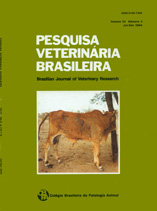 |
|
|
|
Year 2004 - Volume 24, Number 3
|

|
Intoxicação por Crotalaria retusa (Fabaceae) em eqüídeos no semi-árido da Paraíba
|
Nobre V.M.T., Riet-Correa F., Barbosa Filho J.M., Dantas A.F.M., Tabosa I.M. & Vasconcelos J.S. 2004. [Poisoning by Crotalaria retusa (Fabaceae) in Equidae in the semiarid region of Paraíba.] Intoxicação por Crotalaria retusa (Fabaceae) em eqüídeos no semi-árido da Paraíba. Pesquisa Veterinária Brasileira 24(3):132-143. Depto Clínicas Veteri-nárias, Universidade Federal de Campina Grande, Patos, PB 58700-000, Brazil. E-mail: verônica.nobre@uol.com.br
From 2000 to 2003 eight cases of poisoning by Crotalaria retusa L. were observed in horses on 8 farms in the semiarid region of Paraíba and Ceará. C. retusa was found in all farms. The main clinical signs were characteristic of hepatic encephalopathy, with dullness or hyperexcitability, head pressing, compulsive walking or circling and, occasionally, violent uncontrollable galloping. Decreased cranial nerve reflexes, ataxia and weakness were also observed. Other clinical signs were anorexia, weight loss, photosensitization and jaundice. The clinical manifestation period varied from 4 to 40 days, but most horses had a previous history of weight loss. At necropsy the livers were hard, with irregular surface and white areas mixed with dark red areas and increased lobular pattern. Mild jaundice, ascitis, hydropericardium and hydrothorax were also observed. Edema and moderate congestion were seen in the lungs. Histologic changes of the liver were characterized by fibrosis, mainly periportal, megalocitosis and bile duct cell proliferation. Multifocal areas of centrilobular or midzonal hemorrhages were also observed. Centrilobular hemorrhagic necrosis was present in two horses. Alzheimer type II astrocytes were observed, isolated or in groups, mainly in the caudate nucleus and cortex in 4 horses. The poisoning was experimentally produced in 1 adult horse and 3 adult donkeys. The horse received daily 100 g of C. retusa seeds and died 52 days after the beginning of the experiment. The dried whole C. retusa was mixed with grass and given to the 3 experimental donkeys at daily doses of 10g/kg, 5g/kg and 2.5g/kg, respectively. The donkey treated with 5g per kg died 48 days after beginning of the experiment and the other two were sacrificed at 120 days. Clinical signs and pathology were similar to those observed in spontaneous cases, but Alhzeimer type II astrocytes were observed only in the donkey that died 48 days after the beginning of ingestion of the plant material. The concentration of monocrotaline in the whole plant given to the donkeys was 0.5%. |
| |
|
|
| |
|
 |